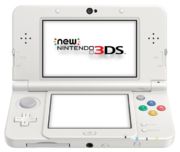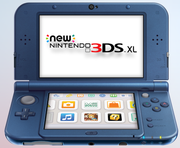From NintendoWiki, your source on Nintendo information. By fans, for fans.
New Nintendo 3DS
Newニンテンドー3DS Nyū Nintendō Surī Dī Esu
|
|
|
| Media
|
Nintendo 3DS Game Card, Nintendo DS/DSi Game Card, digital distribution
|
| Storage capacity
|
256 MB (64MB dedicated to the OS), 10 MB VRAM, microSD memory card
|
| CPU
|
268 MHz ARM11 MPCore quad-core
|
| Model no.
|
KTR-001
|
|
| Can connect with
|
Wii U, Nintendo DS
|
| Input
|
Touch Screen (stylus), ABXY buttons, D-pad, Circle Pad, C-stick, shoulder buttons
|
| Backwards compatible with
|
Nintendo DS/DSi
|
| Services provided
|
Nintendo Network
|
|
| Launch date
|
JP: October 11, 2014
AUS: November 21, 2014
EU: January 6, 2015 (Ambassador's Edition)
February 13, 2015 (general)
NA: September 25, 2015
|
| Discontinue date
|
JP: July 13, 2017[1]
|
| Units sold
|
Worldwide: 2.49 million[2]
NA: 500,000[2]
JP: 1.16 million[2]
|
|
| Predecessor
|
Successor
|
| N/A
|
N/A
|
|
The New Nintendo 3DS is an upgraded model of the Nintendo 3DS, and the fourth system to be released in the Nintendo 3DS family, released in late 2014 in Japan and early 2015 in most other regions. In Europe, the system was originally released with an "Ambassador's Edition" model before the standard release. While it has the same features as the original model, the New Nintendo 3DS has several improvements, such as an improved stereoscopic 3D effect and added buttons.
In most regions, the New Nintendo 3DS was released in two colors: white and black. In North America, only the white system has been released, as part of a bundle with Animal Crossing: Happy Home Designer. However, users can customize their system using removable cover plates.
Features
While the Nintendo 3DS operating system and software remain unchanged, the New Nintendo 3DS makes several changes and improvements to the older models' hardware, as well as adding new features. These include an increase to the amount of RAM, and a quad-core CPU which increases the system's processing power. Among other changes, the Game Card slot and stylus on the New Nintendo 3DS have been moved to the bottom of the system. In addition, the SD card slot has been moved to the back of the system, under the plate covering it, and now only accepts microSD cards. The New Nintendo 3DS features removable cover plates on the back, which can be popped off using the stylus (the bottom plate must still be unscrewed first) and swapped for different designs. The volume slider has been moved to the top of the system.
Among the most notable additions to the hardware are the additional buttons: the New Nintendo 3DS features a built-in C-stick and added shoulder buttons, similar to the Circle Pad Pro. The C-stick, a smaller circle pad, is placed above the ABXY buttons, while the ZL and ZR buttons are placed beside the normal L and R buttons, similar to the original Classic Controller. Because of this, the New Nintendo 3DS has native support for games compatible with the Nintendo 3DS Circle Pad Pro. The ABXY buttons on the New Nintendo 3DS are colored, based on the button colors used for the Super Famicom Similar to Nintendo DS systems, the Start and Select buttons have been moved to under the ABXY buttons, where the Power button would be on older models, while the Power button has been moved to the bottom of the system, near the stylus. The wireless LED has also been moved to the bottom of the system, while the switch has been removed entirely, replaced with a toggle option using the options menu on the home screen.
The New Nintendo 3DS is larger than a normal Nintendo 3DS, and as such has larger screens. This facilitates the use of the system's near-field communication sensor under the bottom screen, allowing native support for products such as amiibo. Disabling wireless communications will also disable the system's NFC sensor. In addition, the New Nintendo 3DS features "Super Stable 3D", which uses the system's inner camera to locate the player's face and adjust the stereoscopic 3D based on the angle of the system compared to the user's face.
Games
The New Nintendo 3DS is compatible with all Nintendo 3DS software, and retains the backwards compatibility of the older models, allowing it to play Nintendo DS Game Cards and DSiWare. Because of the more powerful hardware, similar to later Nintendo DS games after the release of the Nintendo DSi, certain games have been released exclusively for New Nintendo 3DS systems, meaning that they cannot be played on the older models, while others have been designed with improved functionality on New Nintendo 3DS systems.
Accessories
Because of the added features and different design of the Nintendo 3DS, some accessories and peripherals for earlier Nintendo 3DS family systems are incompatible with this model.
amiibo
amiibo are a line of near-field communication based toys released by Nintendo to add content into games. As the system has a built-in NFC receiver, the user only needs to tap the figure or card onto the Touch Screen to use amiibo in compatible software.
New Nintendo 3DS Charging Cradle
The New Nintendo 3DS Charging Cradle is an accessory that allows the player to charge the system without needing a cable. Unlike other iterations of the charging cradle, this version of the device is a stand that the system sits in vertically with the back end facing down, and connects to a Nintendo DSi and Nintendo 3DS AC Adapter through a port on the bottom of the accessory, which the cable is inserted into.
Cover Plates
The New Nintendo 3DS features swappable Cover Plates, which can be replaced and mixed with alternative plates. Many different designs have been released since the launch of the system.
New Nintendo 3DS XL
New Nintendo 3DS XL
Newニンテンドー3DS LL Nyū Nintendō Surī Dī Esu Eru Eru
|
|
|
|
|
| Can connect with
|
Wii U, Nintendo DS
|
| Input
|
Touch Screen (stylus), ABXY buttons, D-pad, Circle Pad, C-stick, shoulder buttons
|
| Backwards compatible with
|
Nintendo DS/DSi
|
| Services provided
|
Nintendo Network
|
|
| Launch date
|
JP: October 11, 2014,
NA, EU: February 13, 2015
AUS: November 21, 2014
KO: May 1, 2015
|
| Discontinue date
|
July 25, 2019
|
| Units sold
|
9.82 million (as of December 31, 2019)
|
|
| Predecessor
|
Successor
|
| N/A
|
N/A
|
|
The New Nintendo 3DS XL is a larger alternative model to the New Nintendo 3DS, released at the same time. The system is the same size as the original Nintendo 3DS XL. While this system uses the same internal hardware as the regular size model, the New Nintendo 3DS XL lacks interchangeable cover plates.
|
|
| Hardware
|
|
| Components / other
|
|
| Games
|
|
| Pre-loaded software / other
|
|
|

|
This article is a stub. You can help NintendoWiki by expanding it.
|
External links
References

|
This article is a stub. You can help NintendoWiki by expanding it.
|
|
|
|
|
|
|
| Other
|
| Standalone consoles
|
Arcade
|
Pokémon
|
Classics
|
Cancelled
|
|
|
|
|
|
|
|




